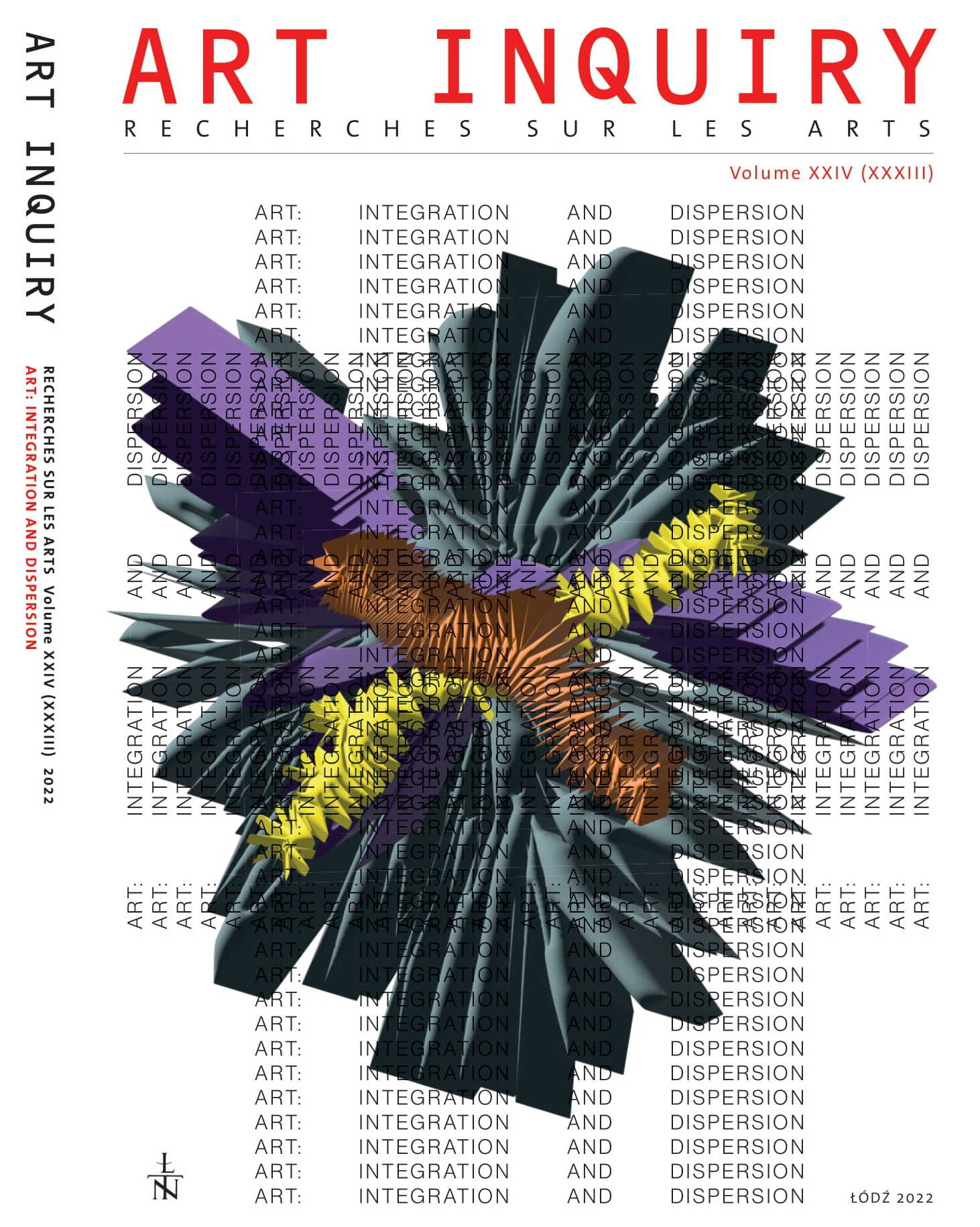Continuity, Discontinuity, Fulguration – Philosophical Contexts of Changes in Art
DOI:
https://doi.org/10.26485/AI/2022/24/1Keywords:
continuity and discontinuity, leap, fulguration, thinking, subject, time, the present, the now moment/currency/Aktualitaet, syndrome, art, avant-garde, modernity, boundaryAbstract
In her article, the author adopts the assumption that interpretations of changes in art, their gradual or abrupt course, depend on the comprehension of time and the conception of the subject. Changes in art and changes in esthetics do not always occur parallel to transformations in the social field. Philosophical premises are one of the basic criteria for divisions in esthetics. The study seeks to answer the question how the forming identity of modern man tries to find a new communication medium; in this case – how this is carried out by art theorists. The object of the analyses are the conceptions that describe changes in art begun by the avant-garde, considered in the broad context of the discourse of modernity. What they have in common is a specific form of identity thinking which takes on the character of a syndrome. The object of the discussion are theories that use categories of philosophical origin: fulguration and planes, continuity and discontinuity, gradualness and the leaps and bounds progression, and those related to them, for example: evolution and devolution, or a negative crisis and a positive crisis. In the context of the discussion on the subject of modernity, the first part refers to the con-ceptions of M. Wallis, S. Morawski, and G. Sztabiński. In the second part, the author asks the question about how much the way of thinking of art has changed in the age of late modernity. She mainly refers to Dieter Mersch’s ‘media reflection’ and Germano Celant’s idea of the present.
References
Adorno Th. W., Dialektyka negatywna, transl. K. Krzemieniowa, PWN, Warszawa 1986
Białostocki J., Kryzysy w sztuce. Materiały Sesji Stowarzyszenia Historyków Sztuki. Lublin grudzień 1985, PWN, Warszawa 1988.
Bielik-Robson A., Inna nowoczesność. Pytania o współczesną formułę duchowości, Universitas, Kraków 2000
Bohrer K. H., Absolutna teraźniejszość, Oficyna Naukowa, Warszawa 2003.
Celant G., Unexpressionism: Art Beyond the Contemporary, Rizzoli, New York, 1988.
Ettlinger L., Historia sztuki jako historia, transl. S. Michalski, in : Pojęcia, problemy, metody współczesnej nauki o sztuce, ed. J. Białostocki , Warszawa 1976.
Greenberg C., Malarstwo modernistyczne, in: idem, Obrona modernizmu. Wybór esejów, eds. G. Dziamski, M. Śpik-Dziamska, Kraków 2006
Habermas J., Modernizm – niedokończony projekt, transl. M. Łukasiewicz, [in:] Postmodernizm. Antologia przekładów, ed. R. Nycz, Wydawnictwo Baran i Suszczyński, Kraków 1998.
Kowalik Ł., Stoicka ontologia Leibniza, Przegląd Filozoficzny – Nowa Seria R. 26: 2017, No. 1 (101), ISSN 1230–1493.
Kowalska B., Od impresjonizmu do konceptualizmu. Odkrycia sztuki, Wydawnictwo Arkady, Warszawa 1989.
Lorenc I., Zacieranie granic: fikcja – rzeczywistość a sztuka współczesna, in: Dystynkcje estetyczne – wyróżnienie i wykluczenie, ed. T. Pękala, Wyd. UMCS, Lublin 2020.
Marquard O., Rozstanie z filozofią pierwszych zasad. Studia Filozoficzne, Oficyna Naukowa 1994, Rozstanie z filozofią pierwszych zasad. Studia Filozoficzne, Oficyna Naukowa 1994.
Mersch D., Teorie mediów, transl. E. Krauss, Wyd. Sic!, Warszawa 2010.
Mersch D., Sprache und Aisthesis. Heidegger und die Kunst, in: Sybille Peters, Martin Jörg Schäfer (Hg.): Intellektuelle Anschauung. Figurationen zwischen Kunst und Wissen, Bielefeld ([transcript]) 2006.
Morawski S., O słabościach praxis neoawangardowej i niedostatkach teorii awangardy, [in:] Wybory i ryzyka awangardy. Studia z teorii awangardy, U. Czartoryska, R.W. Kluszczyński (eds.), Warszawa – Łódź 1985.
Orlik P., Wobec indyferencji. O możliwości konstytuowania całości poindyferencjalnej T. I, Pirron i Hölderlin na ścieżkach indyferencji (aspekt wolności), Wyd. Naukowe IF UAM, Poznań 2013.
Pękala T., Awangarda i ariergarda. Filozofia sztuki nowoczesnej, Wyd. UMCS, Lublin 2000.
Pękala T., Syndrom ciągłości i nieciągłości, “Przegląd Kulturoznawczy” 3(49) 2021.
Pfeiffer-Blattner U., Kontinuität, [in:] Zeit im Lebensverlauf, S. Schinkel, F. Hösel, S.-M. Köhler, i in. (eds.), transcript Verlag, Bielefeld 2020.
Sztabiński G., Inne pojęcia estetyki, Universitas, Kraków 2020,
Wallis M., Ciągłość i nieciągłość w dziejach sztuki, in: Idem, Wybór pism estetycznych, Wprowadze-nie, wybór i opracowanie T. Pękala, Universitas, Kraków 2004.
Wallis M., Przemiany w sztuce i przemiany w estetyce, “Studia Filozoficzne” no. 10 (83), 1972,
Wallis M., Secesja, Wydawnictwo Arkady, Warszawa 1984.
Welsch W., Nasza postmodernistyczna moderna, transl. R. Kubicki, A. Zeidler-Janiszewska, Oficyna Naukowa, Warszawa 1998.
Wenzel A.L., Grenzüberschreitungen in der Gegenwartskunst. Ästhetische und philosophische Positionen, transcript Verlag, Bielefeld 2013.



